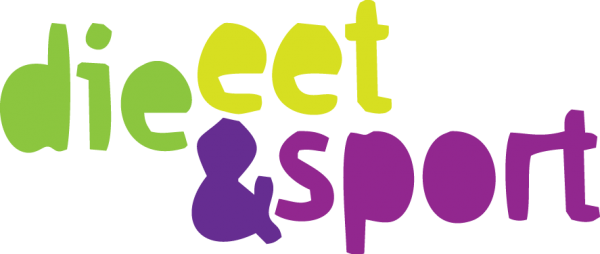— Thanks to intern Manja Peters —
You see them more and more on the shelves of the supermarket: ready-made meals. Very easy and often very tasty too! The variety of ready-made meals is enormous: from fried rice/bami dishes to steamed meals and stews. You put the meal in the microwave, oven or bake the content in a pan, and a few minutes later you can eat.
But are these ready-made meals healthy? In this blog we take a closer look at these type of meals and discuss whether they are good or bad for your health.
Guidelines healthy ready-made meals
The guidelines of the Netherlands Nutrition Centre (‘Voedingscentrum’ in Dutch) describe which criteria a ready-made meal must meet in order to be healthy:1
- 400 to 700 kilocalories per serving;
- At least 150 grams of vegetables;
- Meat, fish, egg, tofu or tempeh up to a maximum of 100 grams, or a maximum of 25 grams of nuts, or a minimum of 60 grams of pulses;
- Potatoes or whole grain cereal products, such as whole grain pasta, whole grain couscous or brown rice;
- Liquid margarine or oil up to a maximum of 15 grams;
- A maximum of 2 grams of salt or a maximum of 2 small portions of ingredients that are not in the Wheel of Five, such as a small amount of sauce. The Wheel of Five is a practical information tool used by the Netherlands Nutrition Centre.
Ready-made meals are not necessarily unhealthy. You do have to be careful which meal you choose. After all, also when you prepare a meal yourself, you keep an eye on which ingredients you use and how much of these ingredients you use. That affects the nutritional value.
For example, an average ready-made meal often contains too little vegetables and fibre. The Netherlands Nutrition Centre recommends at least 150 grams of vegetables per meal and many ready-made meals do not come close to this amount. This also applies to the ready-made pasta meals from Jumbo, PLUS and Albert Heijn.
In addition, many ready-made meals contain too many calories, salt and/or sugar. Chicken satay nasi (‘kipsaté nasi’ in Dutch) from Albert Heijn contains 720 calories! Also, the amount of salt in ready-made meals is often too high. The Netherlands Nutrition Centre recommends eating a maximum of 6 grams of salt per day.2 Because many ready-made meals contain 3 grams of salt, you already get half the maximum daily amount of salt.
When making a trade-off between the different ready-made meals, also pay attention to the amount of fat and the type of fat. How many grams of saturated fat are in the meal? What kind of cooking fat was used? The producer often opts for cheap cooking fats such as palm oil, which makes that the meal is rich in the saturated fat.
Processed food
When you look at the back of various ready-made meals, one thing immediately stands out. The list of ingredients is long! They are usually highly processed products. However, it is better for health and the environment to opt for less processed food. Cooking yourself with fresh products is a good rule of thumb for a healthier and more sustainable diet. Michael Pollan, author of, among others, ‘Food rules’ and ‘In Defense of Food’ has a handy mnemonic for this: “Avoid food products containing ingredients that are: a) unfamiliar, b) unpronounceable, c) more than five in number, or d) that include high fructose corn syrup”.3
Among the ingredients of ready-made meals are also additives. These are excipients that are added to improve the properties of the meal. Think of preservatives (e.g. acetic acid) to extend shelf life, flavor enhancers (e.g. mono sodium glutamate) and colorings (e.g. carotene). Each excipient has its own E-number. And even though E-numbers have a bad name, they actually indicate that the substance is safe to consume. The European Food Safety Authority (EFSA) assesses whether additives can be used safely. If the additive has been properly researched and found to be safe, the substance is given the so-called E-number and can be used by manufacturers in their product.4
Nutritional value
To better understand how to assess ready-made meals, below you will find an overview of 4 healthy and 3 unhealthy ready-made meals, including the nutritional value per meal. Hopefully this will make it easier for you to make a healthy/healthier choice.
1. Fresh steam meal salmon cream sauce from Jumbo5 – Health(y)(ier) option!
Remark: This meal contains a little too much salt and unfortunately no whole grain pasta.
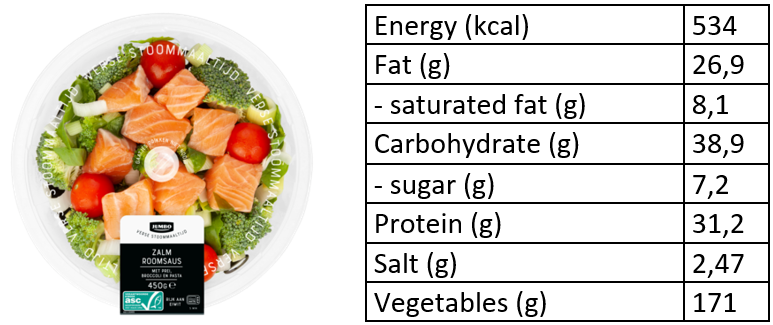
2. Meal salad couscous falafel from Albert Heijn6 – Health(y)(ier) option!
Remark: The amount of fat is a bit high. Due to the dressing, the salad contains a large amount of sugar, but it packed separately.
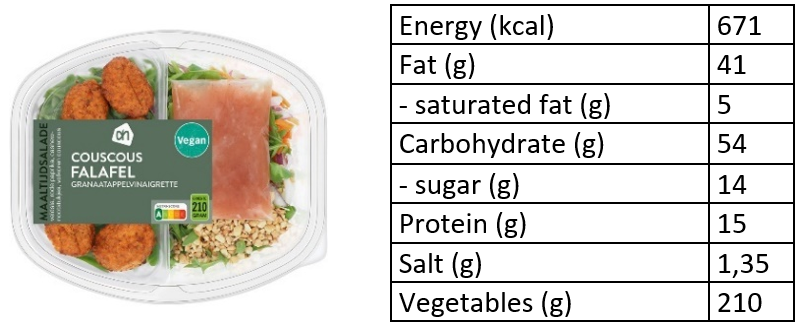
3. Meal salad grilled chicken from Aldi7 – Health(y)(ier) option!
Remark: Unfortunately, this meal does not contain whole grain pasta. Due to the dressing, the salad contains a large amount of sugar, but it is packed separately.
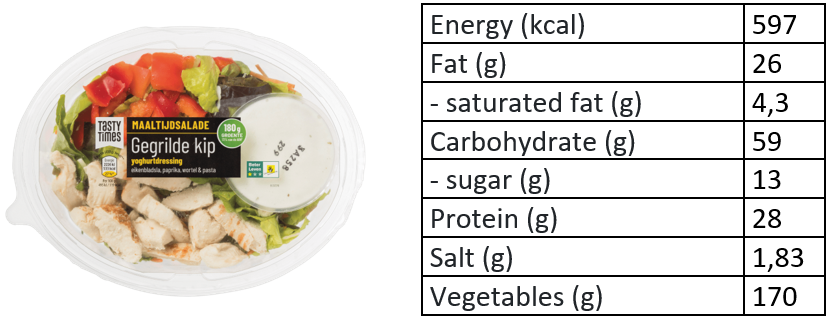
4. Frozen meal lazy vegan tikka masala8 – Health(y)(ier) option!
Remark: This meal contains a little too much salt and white rice instead of brown rice.
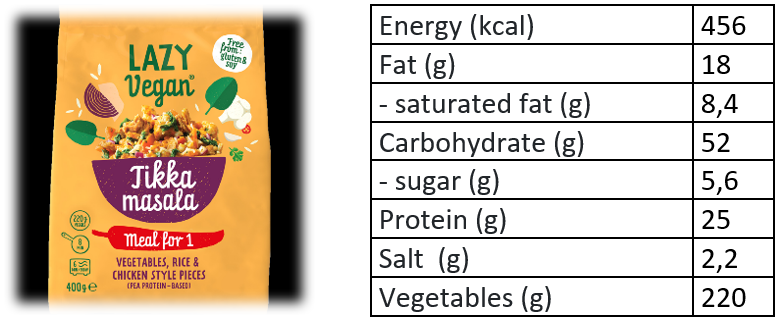
5. Bami satay ajam from Albert Heijn9 – Unhealthy option!
Remark: This meal is very high in fat and contains white noodles. In the meal contains hardly any vegetables and too much salt and sugar, which means the meal contains too many calories too.
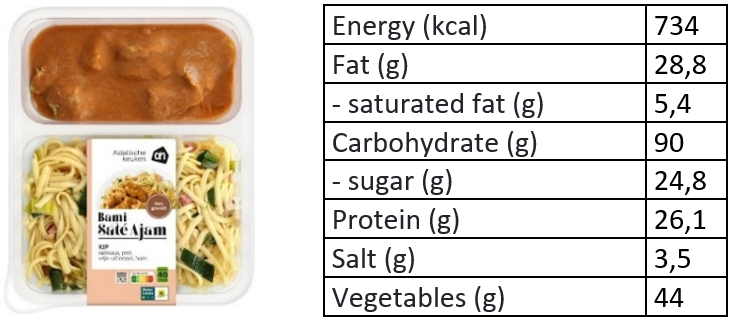
6. Pasta bolognese from Ekoplaza10 – Unhealthy option!
Remark: This meal contains a lot of calories and saturated fat, and hardly any vegetables.
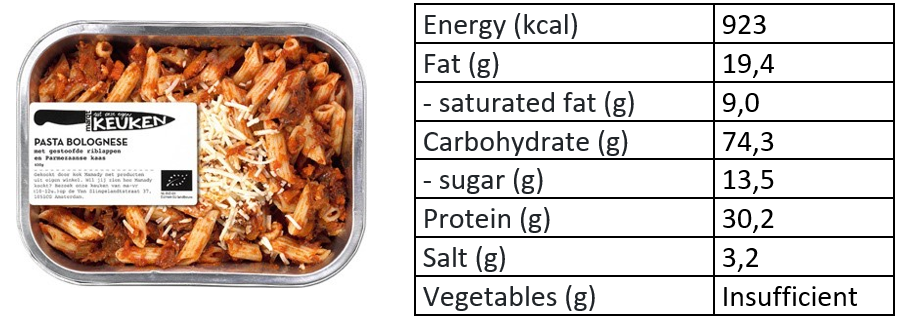
7. Frozen meal stir fry sensation ravioli from Iglo11 – Unhealthy option!
Remark: This meal contains too little vegetables, too much salt and the ravioli is not whole grain.
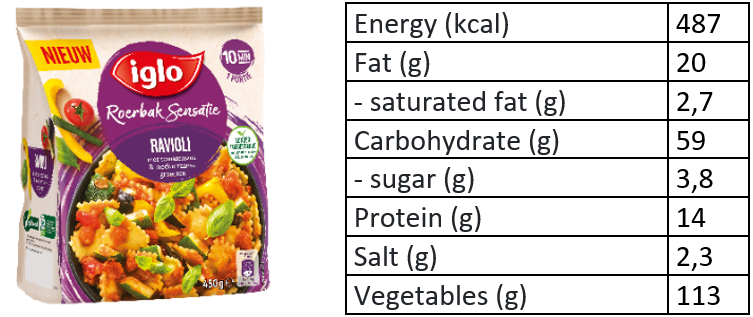
After reviewing the different ready-made meals, a number of things stand out:
– 5 out of 7 meals contain too much salt. That means more than 2 grams of salt per meal.
– Meals with sufficient vegetables meet the guideline regarding the number of calories. Almost all steam meals and meal salads contain more than 150 grams of vegetables.
– Often the dressing in the meal salad creates an unhealthier composition. For example, because the dressing contains a relatively large amount of sugar. By using less dressing or by omitting the dressing, you make the meal a healthier choice.
– With the exception of one meal, these meals do not contain potatoes or whole grain products. Only the meal salad couscous falafel contains whole grain couscous. By using potatoes or whole grain products, meals contains more complex carbohydrates, iron and fibre. Pulses such as chickpeas and lentils also contain these nutrients and can therefore give a meal more nutritional value. The meal salad with whole grain couscous contains 13 grams of fibre, while the meal salad grilled chicken meal salad contains only 5,5 grams of fibre and the fresh steamed salmon only 5,9 grams of fibre.
– Almost all ready-made Eastern meals from the supermarkets, such as the bami satay ajam, contain hardly any vegetables and too much salt.
– The frozen meals are often ready-made pasta meals. These meals consist largely of white pasta, a lot of sauce and again too little vegetables. There are exceptions like the lazy vegan tikka masala; a vegan frozen meal with plenty of vegetables and proteins. The advantage of frozen meals is that they have a longer shelf life without the need to add additives.
Conclusion
Are ready-made meals unhealthy? No, that is certainly not always the case. There are meals that meet the health criteria of the Netherlands Nutrition Center, but the options are limited. But the range of healthy ready-made meals is constantly being expanded, also at supermarkets such as Aldi and Lidl.
Still, preparing a meal yourself remains the best choice, because in that way you can choose the ingredients and quantities yourself. This allows you to influence the composition of the meal, in terms of proteins, fats, carbohydrates and fibres as well as vitamins and minerals. Moreover, cooking yourself is a lot cheaper too.
Of course it doesn’t hurt to eat a ready-made meal every now and then, but you can also prepare a large amount of food yourself and freeze it in portions. This saves time and money! In any case, continue to vary with fresh meals. And if you opt for a ready-made meal, make sure that you choose a healthier option.
1 Voedingscentrum (2022). Zijn kant-en-klaarmaaltijden gezond of ongezond? Geraadpleegd van https://www.voedingscentrum.nl/nl/service/vraag-en-antwoord/gezonde-voeding-en-voedingsstoffen/zijn-kant-en-klaarmaaltijden-ongezond-.aspx
2 Voedingscentrum (2022). Hoeveel zout mag ik eten? Geraadpleegd van https://www.voedingscentrum.nl/nl/service/vraag-en-antwoord/gezonde-voeding-en-voedingsstoffen/hoeveel-zout-mag-ik-eten.aspx
3 Pollan, M. (2009). In defence of food (1e ed.) New York, United States of America: Penguin Books Ltd.
4 EFSA (2022). Food additives. Geraadpleegd van https://www.efsa.europa.eu/en/topics/topic/food-additives
5 Jumbo (2022). Jumbo Verse Stoommaaltijd Zalm Roomsaus 450g. Geraadpleegd van https://www.jumbo.com/producten/jumbo-verse-stoommaaltijd-zalm-roomsaus-450g-387856BAK
6 AH (2022). AH Maaltijdsalade falafel. Geraadpleegd van https://www.ah.nl/producten/product/wi365404/ah-maaltijdsalade-falafel
7 Aldi (2022). Maaltijdsalade kip. Geraadpleegd van https://www.aldi.nl/producten/maaltijden-salades/maaltijdsalades-slaschotels/maaltijdsalade-kip-4360-1-0.article.html
8 Lazy Vegan (2022). Tikka Masala. Geraadpleegd van https://lazyvegan.com/nl/meals/tikka-masala/
9 AH (2022). AH Bami sate ajam. Geraadpleegd van https://www.ah.nl/producten/product/wi455646/ah-bami-sate-ajam
10 Ekoplaza (2022). Pasta bolognese. Geraadpleegd van https://www.ekoplaza.nl/nl/producten/product/pasta-bolognese-0001175253
11 Iglo (2022). Roerbak Sensatie Ravioli. Geraadpleegd van https://www.iglo.nl/assortiment/maaltijden/roerbak-sensatie/iglo-roerbak-sensatie-ravioli-met-tomatensaus-mediterraanse-groenten
